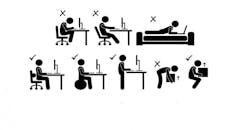Working in manufacturing can put a lot of stress on the body. Depending on the worker’s role in the production process, they might experience issues related to cramped working conditions, heavy lifting, or repetitive stress.
Poor posture is another issue that can cause problems for the health of those who work in manufacturing. Along with that, research suggests that making efforts to improve posture among manufacturing employees can lead to significant increases in production. Workers can improve posture by gaining direct access to physical therapy or simply by being more mindful during the work day.
What Defines Good Posture?
A person’s posture describes the way the individual keeps their body upright against the force of gravity. This includes the way they position their body while standing, walking, lying down, sitting, and during various activities.
If a person has poor posture, it can put unnecessary stress on joints, muscles, and ligaments along different parts of the body. Having good posture means that you stand, sit, walk, and lie in positions that put the least amount of stress on the joints, muscles, and ligaments that support the activity.
While proper posture is better for your overall health, it is not something that comes naturally to most people. Achieving good posture will take some practice and an effort to overcome bad habits that you may have developed over the course of your life.
Posture While Sitting
Many manufacturing employees spend much of their day sitting in a workstation performing a set of tasks. While the ergonomics of the workstation will make a significant difference, it is important for employees to be mindful of their sitting posture. The following are a few tips to improve the sitting posture of people who work in manufacturing:
- Position your buttocks all the way to the back of the chair.
- Try to maintain a straight back and keep your shoulder back.
- Distribute the weight of your body evenly in the chair.
- Keep your knees at or as close to right angles as possible.
- Place your feet flat on the ground.
Posture While Lifting
Lifting can be another issue affecting the posture of those who work in manufacturing. If you are not careful, an improper lifting posture can lead to a back injury. The following are a few tips to help improve the lifting posture of manufacturing employees:
- Get help when lifting objects that are awkward or of considerable weight.
- Make sure you have a firm grasp of the object before lifting.
- If you are lifting an object that is heavy, make sure you have good footing.
- Use a wide stance and get close to the object before you lift.
- Do not bend at the waist to lift objects that are low to the ground.
- When lifting low objects, bend with your knees and hips and let your legs do most of the work.
- Do not reach to lift objects that are on tables, counters, or shelves.
- When lifting off a table, counter, or shelf, slide the object to the edge and lift with the object close to your body.
Posture for Driving
Since most manufacturing employees drive to work, their driving posture can play an important role in ensuring they maintain good posture throughout the day. The following are a few tips for an improved driving posture:
- You should not have to extend your arms to reach the wheel.
- Your knees should be able to bend and reach the pedals comfortably.
- Adjust the height of your seat so your knees are at the same level or higher than your hips.
- Make sure your back is straight and resting on the back of the seat when you drive.
- Use a lumbar roll to support the curve of your back and maintain good posture.
- Adjusting your posture and staying mindful of your position throughout the day can be a chore at the start. But, with some time and attention, your body will adapt the stance naturally and help improve your overall health.
About the Author
Rae Steinbach
Freelance Editor
Rae is a graduate of Tufts University with a combined International Relations and Chinese degree. After spending time living and working abroad in China, she returned to NYC to pursue her career and continue curating quality content. Rae is passionate about travel, food, and writing, of course.
